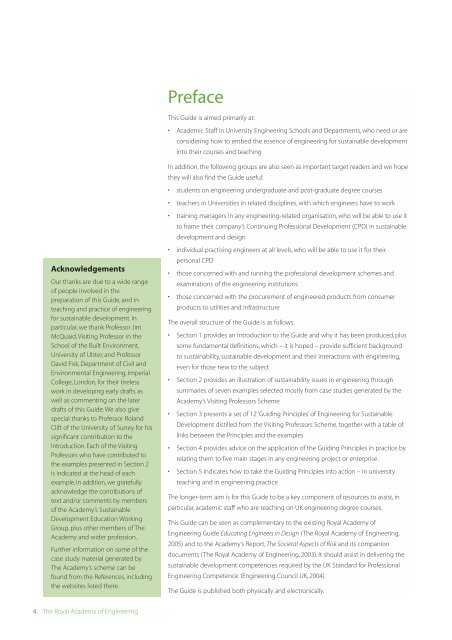Engineering for Sustainable Development: Guiding Principles
Engineering for Sustainable Development: Guiding Principles
Engineering for Sustainable Development: Guiding Principles
You also want an ePaper? Increase the reach of your titles
YUMPU automatically turns print PDFs into web optimized ePapers that Google loves.
Preface<br />
This Guide is aimed primarily at:<br />
• Academic Staff in University <strong>Engineering</strong> Schools and Departments, who need or are<br />
considering how to embed the essence of engineering <strong>for</strong> sustainable development<br />
into their courses and teaching<br />
Acknowledgements<br />
Our thanks are due to a wide range<br />
of people involved in the<br />
preparation of this Guide, and in<br />
teaching and practice of engineering<br />
<strong>for</strong> sustainable development. In<br />
particular, we thank Professor Jim<br />
McQuaid, Visiting Professor in the<br />
School of the Built Environment,<br />
University of Ulster, and Professor<br />
David Fisk, Department of Civil and<br />
Environmental <strong>Engineering</strong>, Imperial<br />
College, London, <strong>for</strong> their tireless<br />
work in developing early drafts as<br />
well as commenting on the later<br />
drafts of this Guide. We also give<br />
special thanks to Professor Roland<br />
Clift of the University of Surrey <strong>for</strong> his<br />
significant contribution to the<br />
Introduction. Each of the Visiting<br />
Professors who have contributed to<br />
the examples presented in Section 2<br />
is indicated at the head of each<br />
example. In addition, we gratefully<br />
acknowledge the contributions of<br />
text and/or comments by members<br />
of the Academy’s <strong>Sustainable</strong><br />
<strong>Development</strong> Education Working<br />
Group, plus other members of The<br />
Academy and wider profession.<br />
Further in<strong>for</strong>mation on some of the<br />
case study material generated by<br />
The Academy’s scheme can be<br />
found from the References, including<br />
the websites listed there.<br />
In addition, the following groups are also seen as important target readers and we hope<br />
they will also find the Guide useful:<br />
• students on engineering undergraduate and post-graduate degree courses<br />
• teachers in Universities in related disciplines, with which engineers have to work<br />
• training managers in any engineering-related organisation, who will be able to use it<br />
to frame their company’s Continuing Professional <strong>Development</strong> (CPD) in sustainable<br />
development and design<br />
• individual practising engineers at all levels, who will be able to use it <strong>for</strong> their<br />
personal CPD<br />
• those concerned with and running the professional development schemes and<br />
examinations of the engineering institutions<br />
• those concerned with the procurement of engineered products from consumer<br />
products to utilities and infrastructure<br />
The overall structure of the Guide is as follows.<br />
• Section 1 provides an Introduction to the Guide and why it has been produced, plus<br />
some fundamental definitions, which – it is hoped – provide sufficient background<br />
to sustainability, sustainable development and their interactions with engineering,<br />
even <strong>for</strong> those new to the subject<br />
• Section 2 provides an illustration of sustainability issues in engineering through<br />
summaries of seven examples selected mostly from case studies generated by the<br />
Academy’s Visiting Professors Scheme<br />
• Section 3 presents a set of 12 ‘<strong>Guiding</strong> <strong>Principles</strong>’ of <strong>Engineering</strong> <strong>for</strong> <strong>Sustainable</strong><br />
<strong>Development</strong> distilled from the Visiting Professors Scheme, together with a table of<br />
links between the <strong>Principles</strong> and the examples<br />
• Section 4 provides advice on the application of the <strong>Guiding</strong> <strong>Principles</strong> in practice by<br />
relating them to five main stages in any engineering project or enterprise<br />
• Section 5 indicates how to take the <strong>Guiding</strong> <strong>Principles</strong> into action – in university<br />
teaching and in engineering practice<br />
The longer-term aim is <strong>for</strong> this Guide to be a key component of resources to assist, in<br />
particular, academic staff who are teaching on UK engineering degree courses.<br />
This Guide can be seen as complementary to the existing Royal Academy of<br />
<strong>Engineering</strong> Guide Educating Engineers in Design (The Royal Academy of <strong>Engineering</strong>,<br />
2005) and to the Academy’s Report, The Societal Aspects of Risk and its companion<br />
documents (The Royal Academy of <strong>Engineering</strong>, 2003). It should assist in delivering the<br />
sustainable development competencies required by the UK Standard <strong>for</strong> Professional<br />
<strong>Engineering</strong> Competence. (<strong>Engineering</strong> Council UK, 2004).<br />
The Guide is published both physically and electronically.<br />
4 The Royal Academy of <strong>Engineering</strong>
















